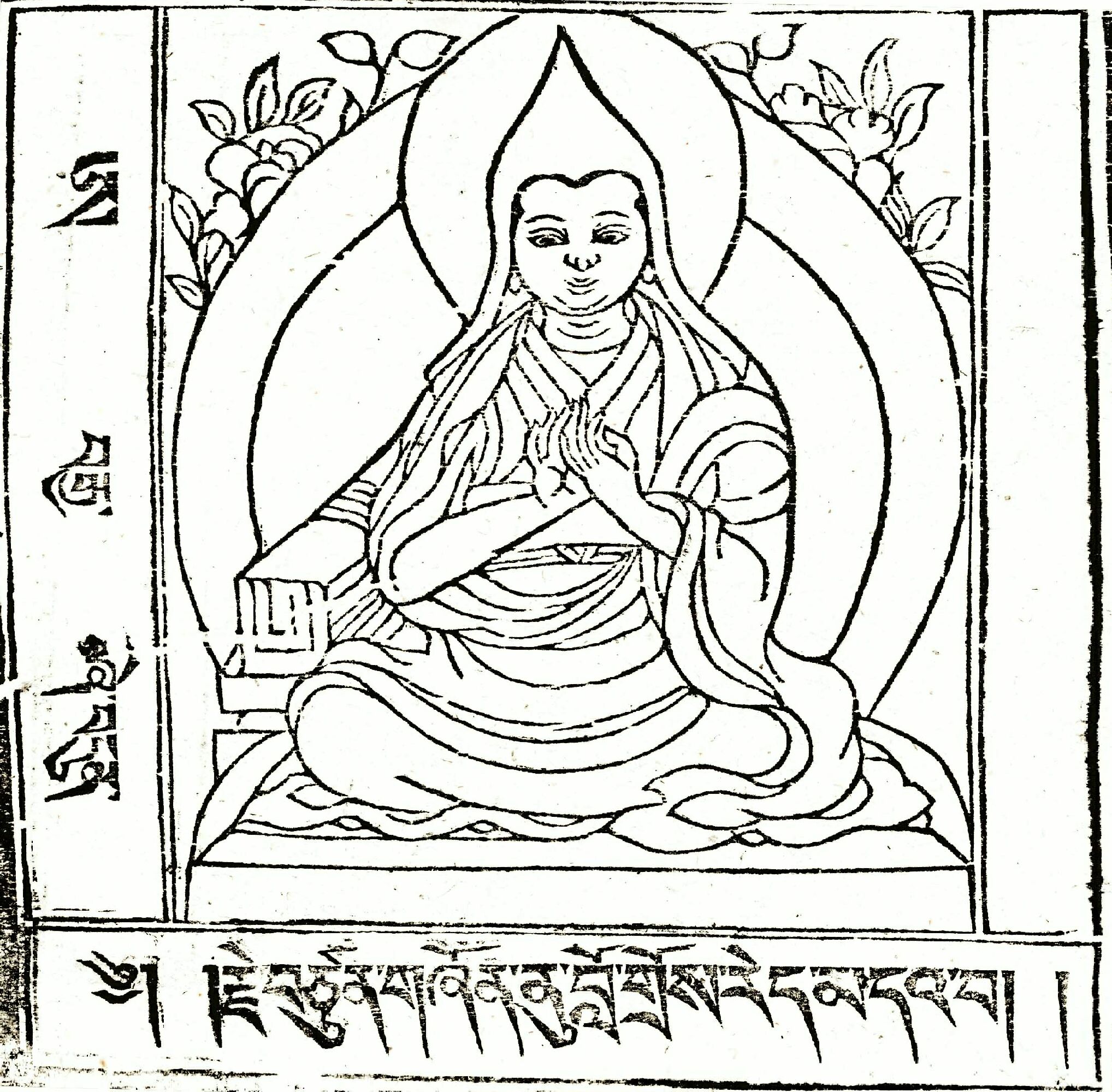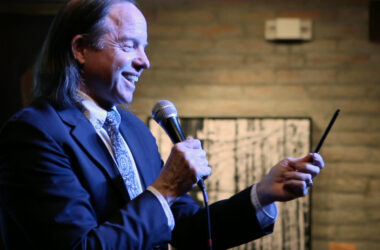Class 24: My Hair on Fire
[su_icon icon=”icon: link” color=”#ff1259″ size=”20″ shape_size=”12″ url=”https://youtu.be/mDKCpXTjHHE?t=7s” target=”blank”]Video[/su_icon]Hi, welcome back to the Wheel of Life at-home retreat, where this horse race is almost finished. We’ve reached session 24 out of twenty-five sessions, and this session is called “My Hair on Fire,” and the picture you see here is of a guy with his clothes and his hair both on fire. Let’s go to the Tibetan and we can follow why we use this image.
de na she tring le (DES NA BSHES SPRING LAS). she tring (BSHES SPRING) means a famous book by Arya Nagarjuna. It’s called the Letter to a Friend. His friend was King Udayibhadra, and he sent this letter to the king. I think it’s interesting that Pabongka Rinpoche quotes it so frequently in his lam rim (LAM RIM), because I had the good fortune to work on that text a lot when I was very young.
My friend Art Engle–a fellow student, a dear fellow student, and my teacher translated that book. And what I realized by studying that book is that it’s a lam rim. So we tend to think that the lam rim, the steps of the path teaching, started in Tibet–but it’s not true. This book in Sanskrit is called Suhrlekha(Suhṛllekha). It’s by Nagarjuna, almost two thousand years ago, and it’s kind of a really beautiful lam rim. And Pabongka Rinpoche quotes two famous verses here.
go-am gu la lobur me shor na (MGO’AM GOS LA GLO BUR ME SHOR NA). Suppose suddenly your clothes or your hair caught on fire. And by the way, this happened with somebody during my three year retreat. Somebody got too close to the fire, and their clothes caught on fire, and it’s very very dangerous. So you have to actually–they taught us in the Boy Scouts that you have to knock them down immediately, push them down, and then roll them. So I did it. de dak chir dok gyiwa tang ne kyang (DE DAG PHYIR BZLOG BGYI BA BTANG NAS KYANG). If your clothes or your hair catch on fire, you’re not going to do some other things. You’re going to immediately do whatever you can to stop the fire. Like you’re not going to say, “My hair’s on fire, but I think I’ll finish my coffee first.”
[su_icon icon=”icon: link” color=”#ff1259″ size=”20″ shape_size=”12″ url=”https://youtu.be/mDKCpXTjHHE?t=4m11s” target=”blank”]Video[/su_icon]We have a job like that. yang si mepar gyi (YANG SRID MED PAR BGYI)–we want to put out the fire of rebirth. We have a very short time in this life. While you’re healthy, while you can still meditate, while your mind is still clear, while you still have food and a place to stay, you don’t have time to do a lot of other things. This fire is burning you now. So you have to stop everything else and try to put out this fire.
di le che chok dupa shen ma chi (‘DI LAS CHES MCHOG DGOS PA GZHAN MA MCHIS)–There’s nothing more important that you have to do in your life. Generally, I have followed this in my life. Generally. And the fact is that if you want to put out that fire, you will not have time to do many other things. So you might have to give up many of the things that other people do in their life. And I’ve been doing that for almost fifty years, and I can report, I can tell you, I think I made the right decision. So for example, I’m very bad at buying birthday presents for my family. And it’s not that I don’t love them, we love each other very much. But if I spend the time to go to the store to pick a gift for every family member–we have a big family–then I won’t have time to do those three things:
(1) vipashyana–try to understand dependence and emptiness. (2) Shamatha–do my meditation practice every day without breaking it to go to the store to buy birthday presents, and then (3) the daily study and practice of morality, which I need to support my meditation.
So Nagarjuna says here, “it’s just like your hair is on fire.” There’s nothing else more important right now. Put out that fire, then do other things. Become a Buddha, and then buy birthday gifts. tsultrim dak dang (TSUL KHRIMS DAG DANG)–how are you going to put out this fire? tsultrim dak dang sherab samten gyi (TSUL KHRIMS DAG DANG SHES RAB BSAM GTAN GYIS). You should use tsultrim (TSUL KHRIMS), which means treating other people sweetly, nicely, not hurting other people, sherab (SHES RAB)–that wisdom which understands emptiness. Vipashyana is the highest form. And then shamatha, a good steady state of meditation.
If you remember, these are the three parts of the woodcutter: (1) sharp axe, which is wisdom; (2) good focus, like that unshaking flame to hit in the right place; and then (3) two strong arms of morality to swing the axe. If you use those three, you will reach nyengende (MYA NGAN ‘DAS). The text says nyengende–“Nirvana.” Also called shiwa (ZHI BA), which means “peace.” Also called dulwa (DUL BA), which means you have “controlled yourself completely.” Also called drimepay go pang (DRI MED PA’I GO ‘PHANG)–“the state beyond all impurities.” Also called mi ga (MI RGA)–you “don’t have to get old anymore.” mi chi (MI ‘CHI) means that you “don’t have to die anymore.” se mi tsel (ZAD MI’TSAL) means “this life and this purity will never end.”
[su_icon icon=”icon: link” color=”#ff1259″ size=”20″ shape_size=”12″ url=”https://youtu.be/mDKCpXTjHHE?t=9m47s” target=”blank”]Video[/su_icon]In “The Letter to the Friend,” the last line is strange. sa chu me lung nyi da drel tob dzu (SA CHU ME RLUNG NYI ZLA BRAL THOB MDZOD)–you should try to reach that place where you don’t have earth, water, fire, and wind. And by the way, also get rid of the sun and the moon. Now for that last line, I thought we should go on a little side trip, which I like to do. What’s that last line mean? The other words for Nirvana are easy.
“Peace” means, of course, I don’t have negative emotions anymore–it’s peaceful. Dulwa means “I’m self controlled.” Of course. dri ma mepa (DRI MA MED PA)–no more problems in my body, no more problems in my mind. Don’t have to get old, don’t have to die, my pure life goes on forever. That’s easy. But what’s it mean–sa chu me lung nyi da drel–what’s it mean to overcome earth, water, fire, wind, sun, and moon? I went to get you some commentaries. The one I enjoyed the most was by a great Mongolian author. His name is Chuje Ngawang Pelden. chuje (CHOS RJE) means “Dharma Lord.” He lived about … I think two hundred years ago. Here’s his commentary to that last line.
So we’re going deeper, and that’s what we do, and that’s why this lam rim (LAM RIM) teaching is so slow! sa chu me lung nyi da drel top dzu–he says, “Now what about this strange last line?” So there’s a Mongolian master, he says, “What about this strange last line?” He says, well sa chu me lung [SA CHU MED RLUNGS], these four elements, that’s easy. di la che (‘DI LA BYED) means “they refer to” the four elements. And it means after you reach Nirvana or become a Buddha, you don’t have this normal body made of these four elements. You have what we call a “rainbow body.” Why is it called rainbow body? From a distance, a rainbow looks like it has a shape and it looks like it has colors. But then when you come up close to the rainbow, you can put your hand through it, and a Buddha’s physical body is similar.
Now here’s the part that I like about his commentary, it’s very sweet. He says nyi dz (NYI ZLA). Now why do they mention sun and the moon? kyepar pak tu le (KHYAD PAR ‘PHAGS BSTOD LAS)–This is a famous book called “The Extraordinary Praises” or something. “Praise of the One Who is Extraordinarily Superior.” It’s a poem. [Xiaoping question inaudible] No, he’s going to quote, he’s going to quote a book. It’s a famous eulogy. Eulogy means “a poem of praise,” found in the Tengyur. And it says,
[su_icon icon=”icon: link” color=”#ff1259″ size=”20″ shape_size=”12″ url=”https://youtu.be/mDKCpXTjHHE?t=14m15s” target=”blank”]Video[/su_icon]ne tsu nyima ngul ne no (NE TZOS NYI MA BRNGOL NAS NO), which is probably mistake–everything is misspelled and mis-carved here. I had to replace a lot of words. But he says, tarpa chipar she che drak (THAR PA MCHIS PAR BSHAD CES GRAGS)–The parrot, the green parrot–the bird who talks, he poked the sun with his beak, and then they say he got to Nirvana. What’s that all about? This is supposed to explain “the sun and the moon.” There’s “no more sun, there’s no more moon.” Forget the sun and the moon. drang song (DRANG SRONG) means “a Hindu saint.” He’s called Gyepaybu (RGYAS PA’I BU). With some miracle powers, he took a parrot or he became a parrot. It’s not clear. He flew to the sun and he poked a hole in the sun, and then that saint got into the hole and he reached Nirvana.
So this Mongol master–who is a great, great master–he says Shantideva’s, oh sorry, Nagarjuna’s book, they are criticizing this idea that Nirvana is some place on the other side of the moon or something like that. So he criticizes–he says “sun and moon”–when the book says “you are free of the sun and moon,” it means you are free of this dumb idea about what is Nirvana. I found another interesting … yeah, here is a commentary by Rendawa. Rendawa was a Sakya master who was the teacher of Tsongkapa.

And when he explains the sun and moon, chi rulpa kachik (PHYI ROL PA KHA CIG)–some non-buddhists say, yang chi rulpa kachik (YANG PHYI ROL PA KHA CIG). It’s at the end of his quotation. kawa dung gya pu ba showa mo muk tik dok (KHA BA DUNG RGYA SPOS BA ZHO BA MO MU TIG MDOG). It says some people think when you reach Nirvana you go into some white light. It’s like the color of snow, or the color of a white shell, or like the color of pearl, or the color of yoghurt. And it looks like an umbrella covers you. And these are all weird ideas about Nirvana. He says when this book says, “you go beyond the sun and the moon,” it means you go beyond these dumb ideas about “Nirvana is like a big umbrella that’s colored white and you stay under the umbrella like in a donut of the sun.” And you can say those are just stupid old ideas from some weird groups in India. But you might examine what ideas you have about what is Nirvana, and maybe it’s not much different from the white umbrella.
[su_icon icon=”icon: link” color=”#ff1259″ size=”20″ shape_size=”12″ url=”https://youtu.be/mDKCpXTjHHE?t=19m02s” target=”blank”]Video[/su_icon]Now just for fun, which I enjoy doing, I thought you would like to go to this is a book by Pabongka Rinpoche himself. And this is a beautiful kind of genre of book, it’s a type of literature. And it’s called dri len (DRIS LAN). dri len means “question and answer.” So even in this course, we’re going to be doing a special master class, and I’ll be accepting questions from you, and I’ll be giving answers live. Also in the expanded course, you’ll be able to ask questions directly online or in person, or by internet to senior ACI teachers. But in ancient times, somebody would sit there carving the question. So here’s a question that somebody actually asked Pabongka Rinpoche, probably about a hundred years ago.
she tring le sa chu me lung nyi da drel top dzu (BSHES SPRING LAS, SA CHU ME RLUNG NYI ZLA BRAL THOB MDZOD)–So what about that last line of “The Letter to a Friend,” which talks about you reached Nirvana where you don’t have sun and moon anymore? Oh, and here’s Pabongka’s own answer because he didn’t answer it … he didn’t ask the question in his lam rim, but somebody asked him later, “What was that line?” And by the way, this is the great benefit of having five million pages of scriptures digitalized in the last thirty-three years. And I know many of you watching this lam rim are helping to organize fundraising for that digitalization. I wanted to thank you for that. And the reason I can go deeper with you is because of your fundraising. And it definitely helps poor people around the world who we train. For thirty-three years. And it’s beautiful now, as some of those ladies that I met in the first year of this project, they had children, and now those children are working next to them on the computer.
Ok, so here it says, chi rolpa ga shik gi jungwa shi dang nyi da sok la top ja tartuk tu dzinpa dang (PHYI ROL PA ‘GA’ ZHIG GIS ‘BYUNG BA BZHI DANG NYI ZLA SOGS LA THOB BYA MTHAR THUG TU ‘DZIN PA DANG)– It says “some people”–ancient weird schools–they think Nirvana is like a white light where you go and you stay in this white light.” tarpa suk chen du dupa (THAR PA GZUGS CAN DU ‘DOD PA)–These are strange ideas that Nirvana is a physical place. But if you really want to go to the real Nirvana, you need those three trainings: (1) morality, (2) concentration, and (3) wisdom.
Yeah, I have to say, a lot of people think that if you study this section that we’ve covered with twenty-five classes, if you study it well, then you will reach Nirvana. People think it’s like you got very drunk. You are like this … for the rest of time … and you are just like in another space. This is not Nirvana at all. Nirvana’s definition: nyondrip ma lupar pangpay sosor tak gok (NYON SGRIB MA LUS PAR SPANGS PA’I SO SOR BRTAG ‘GOG)–You basically get rid of your anger, and jealousy, and other negative emotions, forever. That’s Nirvana.
[su_icon icon=”icon: link” color=”#ff1259″ size=”20″ shape_size=”12″ url=”https://youtu.be/mDKCpXTjHHE?t=24m04s” target=”blank”]Video[/su_icon]So Xiaoping, for example, yesterday she was translating for me here, and today she’s translating for me here–same place. Then it’s possible that she reached Nirvana last night. And she won’t look any different. Okay, so you have to understand that. The person sitting next to you, they could have reached Nirvana last night because of these great classes. And they’re not going to change–their outer appearance is not going to change. They don’t have any more negative emotions and you cannot make them angry. Okay, let’s go back to lam rim. But that kind of going deeper is only possible because we have a database that we built for thirty-three years. I estimate we have a hundred and seventeen years to go, so I hope you will continue to help, and I thank you for your help so far. Especially Gold Club friends.
che sungpa tar kyebu dring gi nyam su lang ja ni (CES GSUNGS PA LTAR, SKYES BU ‘BRING GI NYAMS SU BLANG BYA NI) Well, what is it that people in this medium motivation–what are they trying to reach? They just want to stop suffering forever for themselves. Well, what should they be focusing on? hlakpay lappa sum (LHAG PA’I BSLAB PA GSUM)–those three extraordinary trainings. (1) Always being nice to other people. (2) Doing your meditation every morning. (3) And study, study, study about emptiness.
sum yinpe kyebu chenpoy chu kor mi tri na kamdir lappa sum ka che gu (GSUM YIN PAS SKYES BU CHEN PO’I CHOS SKOR MI ‘KHRID NA SKABS ‘DIR BSLAB PA GSUM KA ‘CHAD DGOS)–Now, if I wasn’t going to teach you guys the highest tract, Mahayana tract, if this was just a series of lectures about how to reach Nirvana not Buddhahood–of course Buddhahood means your whole body changes, your whole mind changes, you’re able to help people on billions of planets at the same time. Nirvana just means me, one person here on this couch, I don’t have anger, I don’t have jealousy. Which by the way, that means you got out of the wheel of Life.
But not everybody who reached Nirvana reached Buddhahood. Buddhahood, your whole being changes. And you are able to help countless beings on countless planets at the same time. Then Pabongka Rinpoche says, I’m not done with you after I finish this Nirvana thing. I have a big plan for you. We’re going to go to the greater way teachings, Mahayana teachings, where you learn to become a Buddha. To get to that Buddhahood you’re also going to need these same three trainings. So if I wasn’t going to teach you this highest path, if I was just teaching you about Nirvana, well then, I would teach you the details of those three trainings today. But, I am going to teach you those higher goals, so I think we’ll save two of those trainings for later.
[su_icon icon=”icon: link” color=”#ff1259″ size=”20″ shape_size=”12″ url=”https://youtu.be/mDKCpXTjHHE?t=29m04s” target=”blank”]Video[/su_icon]shamatha training–deep meditation. vipashyana training–special view of emptiness. I’ll teach those to you guys later. And by the way, that’s my plan also. After we finish this book, because Pabongka Rinpoche doesn’t spend much time on shamatha and vispashyana in this book. A little bit, but not much, at the end of this book we’re going to go to The Great Book on the Steps of the Path, Lam Rim Chenmo (LAM RIM CHEN MO). That will take us thirteen more years to finish. We will just do the part on shamatha and vipashyana. Okay, so I’m telling you, and Pabongka’s telling you, we’ll get there later. Those two trainings we’ll cover later.
So I’m going to tsultrim kyi lappa tsel du tun (TSUL KHRIMS KYI BSLAB PA RTZAL DU BTON) means “let’s focus on ethical way of life.” That’s the chak she (PHYAG BZHES) here. chak she means “that’s the high lamas’ tradition at this point.” We just focus on morality because we’re going to teach you shamatha and vipashyana later. Then he quotes again, Nagarjuna’s Letter to a Friend.
trim ni gyu dang mi gyuy sa shin du yunten kun gyi shi ten lakpar sung (KHRIMS NI RGYU DANG MI RGYU’I SA BZHIN DU YON TAN KUN GYI GZHI RTEN LAGS PAR GSUNGS). How can I describe the practice of living an ethical life? Think about this planet Earth. The big dirt, the huge, huge, huge–all the countries are resting on this planet. gyu dang mi gyuy sa (RGYU DANG MI RGYU’I SA) is an old, old joke. The dirt of this planet holds up everything that is moving and everything that is not moving. So right now, we’re in Sedona, Arizona. I don’t know if you can see, but these red mountains in the background are very, very famous. Six million people a year come here to visit. And the earth patiently, quietly, holds up those mountains all day and all night. And if you look out the window here, you can see some cars moving. And the earth patiently holds them up all the time also–day and night.
So whether things are moving like the cars, or whether things are not moving like the red mountains, the earth is very patient. He just holds them up. And Nagarjuna says, “Your morality is like that.” Okay, you you want to meditate, you want to see emptiness directly? By the way, the meditation is like the mountains, and the seeing emptiness directly is like the cars. But somebody patient, quiet, always there–has to be under–foundation–and that’s morality. shepa tar yunten tamche kyi shi yinpe (ZHES PA LTAR YON TAN THAMS CAD KYI GZHI YIN PAS)–being nice to other people is the foundation of every good quality.
tsultrim nampar dakpa gel che (TSUL KHRIMS RNAM PAR DAG PA GAL CHE)–therefore, never hurting any other person is extremely important. di ni sanggye kyi tenpay tsawa (‘DI NI SANGS RGYAS KYI BSTAN PA’I RTZA BA)–treating other people nicely is the root of all Buddhism. sung na pen yun che (BSRUNG NA PHAN YON CHE)–if you keep an ethical way of life, if you are nice to other people, the benefits that come to you are unbelievable. ma sung na nye mik kyang shintu che te (MA BSRUNGS NA NYES DMIGS KYANG SHIN TU CHE STE) and if you don’t keep to an ethical way of life, and you do hurt other people, you cannot imagine the kind of trouble you are making for yourself.
[su_icon icon=”icon: link” color=”#ff1259″ size=”20″ shape_size=”12″ url=”https://youtu.be/mDKCpXTjHHE?t=34m33s” target=”blank”]Video[/su_icon]And I’ll tell you another important thing that Buddha said about being nice to other people. If people in any city or country are keeping their commitment to be nice to other people, then Buddha said “Then Buddhism is there.” And if they’re not keeping those kinds of commitments to be nice to other people, then you cannot say Buddhism has reached that place. Then he repeats: gelong dulwa dzinpa tenpa yu la (DGE SLONG ‘DUL BA ‘DZIN PA BSTAN PA YOD LA) If there’s one person in a city keeping to a way of life where they never hurt other people, then Buddhism exists in that city. Even if there’s a tantra–high secret teaching, reached that city, and everybody’s ringing their bells, but if they’re not being nice to other people, then we can say the Buddhist teachings did not reach that place, even though people are practicing the highest teaching there–but they are not moral.
After I disappear from this world, after I reach my final Nirvana, part of me will stay in this world. And that part of me will be your teacher forever. And that’s keeping your vows and not hurting other people. So if one person in this world is keeping their commitment never to hurt other people, then Buddha said, “You can say I’m still here”.
Therefore, the Buddha said himself, nga ni nyengende gyur na di ni kyu kyi tunpa she (NGA NI MYA NGAN ‘DAS GYUR NA,’DI NI KHYOD KYI STON PA ZHES) After I disappear from this world, after I reach my final Nirvana, part of me will stay in this world. And that part of me will be your teacher forever. And that’s keeping your vows and not hurting other people. So if one person in this world is keeping their commitment never to hurt other people, then Buddha said, “You can say I’m still here.” Final sentence of this series, and then the twenty-fifth session will be a review.
So listen and let it be like a mantra for you. Listen to the words. It’s a blessing. rang gyu kyi tsultrim la tunpay ku tsab yin nyam du che tre che ne sun gu (RANG RGYUD KYI TSUL KHRIMS LA STON PA’I SKU TSAB YIN SNYAM DU GCES SPRAS BYAS NAS BSRUNG DGOS). So most of you listening, you probably took some kind of Buddhist vows, at least the ten good deeds. No killing. No stealing. No hurting other people’s relationships, etcetera. We can say that in your mind stream, you are keeping this way of life where you are nice to other people. So then Pabongka says, so we can say, okay, you don’t have to be perfect, but those of you who are trying to keep your six-times book, and since you heard about this teaching about seeds, you are trying to be nicer to other people, as long as you generally, imperfectly, are trying to be nice to other people–not perfectly, we can say the Buddha is alive inside of you. And che tre (GCES SPRAS) means “take good care” of that Buddha. It’s most precious thing in your life.
That’s the end of session 24. In session 25, we’re going to do a review of the whole twenty-five sessions. We’ll see you then.
I know Xiaoping you’re very tired, and you’ve been working very hard, and thank you for translating.








